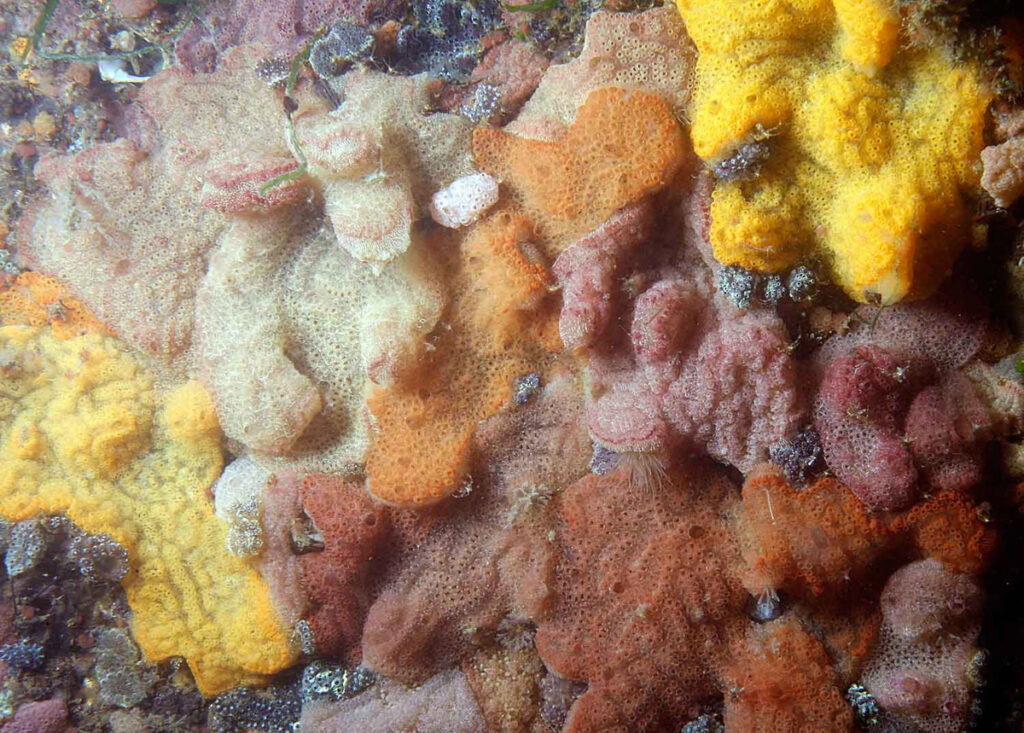
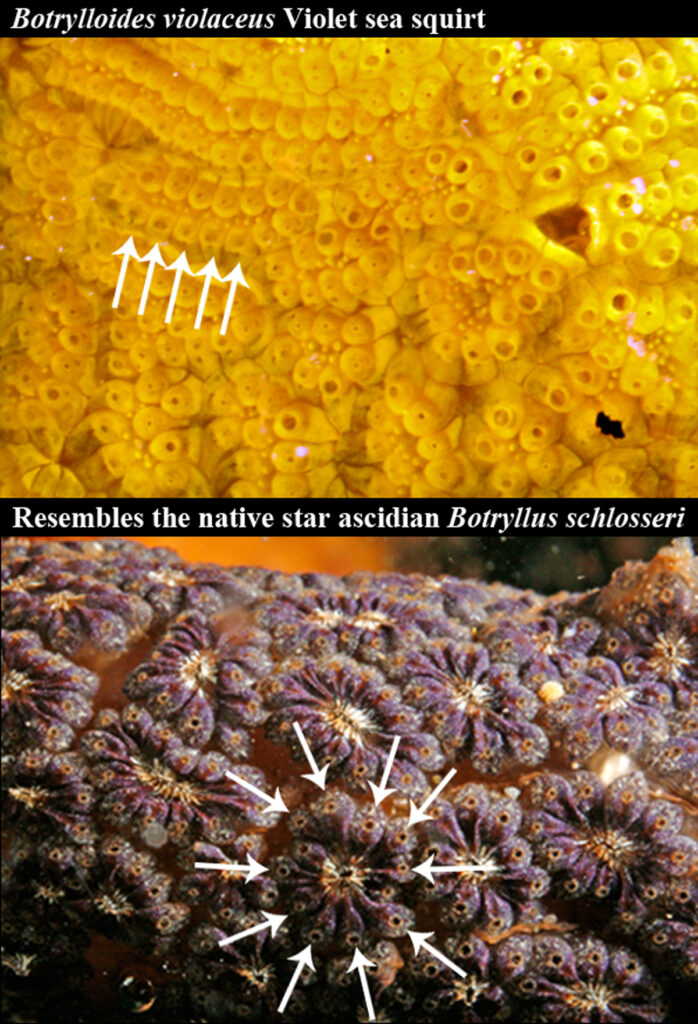
The violet sea squirt
Botrylloides violaceus
Also known as: –
What does it look like?
This colonial sea squirt can be found in various bright colours, (yellow, pink, deep red, forming large sheets mostly on hard substrates.
Distinguishing features
The zooids (individuals) in the usually brightly coloured colonies can easily be distinguished from each other and are neatly arranged in rows. Each of the individuals in the colony has a small round “inhalant” opening. These openings in the colony will close when the colony is disturbed. Alongside the margin (edge) of the colony, a zone with round ball like structures are visible, which are distinctly smaller than the individuals in the colony.
Confusion with similar species
The native sea squirt Botryllus schlosseri resembles Botrylloides violaceus. All zooids in B. schlosseri colonies are arranged in circle, while most zooids in B. violaceus are arranged in rows. A relatively rare native species that resembles B. violaceus is Botrylloides leachii. These two species can be distinguished using microscopic analyses of the larvae, which become distinctly larger in B. violaceus. B. leachii colonies usually have two colours while most B. violaceus colonies usually have only one colour.
Various sponge species may resemble Botrylloides violaceus. In sponges the smaller “inhalant holes” tend to be unequal and irregular in size and form, while all small holes in a colonial sea squirt are equal in size and form. In addition, one may notice movement in an ascidian colony when touching it, as it has muscles that may retract upon touch, closing all holes. A sponge does not have muscles.
What is its origin?
Northwest Pacific
Habitat
This is a fouling species that can inhabit hard natural and artificial substrates, from cobble and gravel, to shellfish beds and floating pontoons. In more sheltered areas the species can grow over sandy and muddy bottoms. It lives mainly in submerged habitats and can be very abundant on marina pontoons, boat hulls and other marine floating structures like those used for mussel culture. The species can withstand short periods above water, e.g. just above the low water line, although it does not survive being exposed to fresh water (rain) very well. This enables it to settle for example on the underside of oyster trestles, but not on top of them. It is often found in the same habitat as the invasive carpet sea squirt Didemnum vexillum.
Presence in Ireland
Present on the island of Ireland
Behaviour and Spread
Botrylloides violaceus colonies produce larvae with a relatively short pelagic stage of a few hours to days in spring. The colonies can rapidly expand in summertime and only partly die off in winter. Spread is assumed mainly to take place by hull fouling and shellfish transports.
Potential nuisance for aquaculture
The species can cause a nuisance for rope mussel producers as it can cover the mussels and the lines with a layer that appears to be unsuitable for settlement of mussel seed. However, as mussel seed usually settles just before the settlement of this sea-squirt, its impact is limited. The violet sea squirt is also found on bottom culture mussels and oysters, and on the shadow (under)side of trestles. It does not seem to suffocate or compete with the shellfish for nutrients or space; however, it may reduce the water (and nutrient) flow to the shellfish, possibly resulting in lower meat yields
Key Management Actions
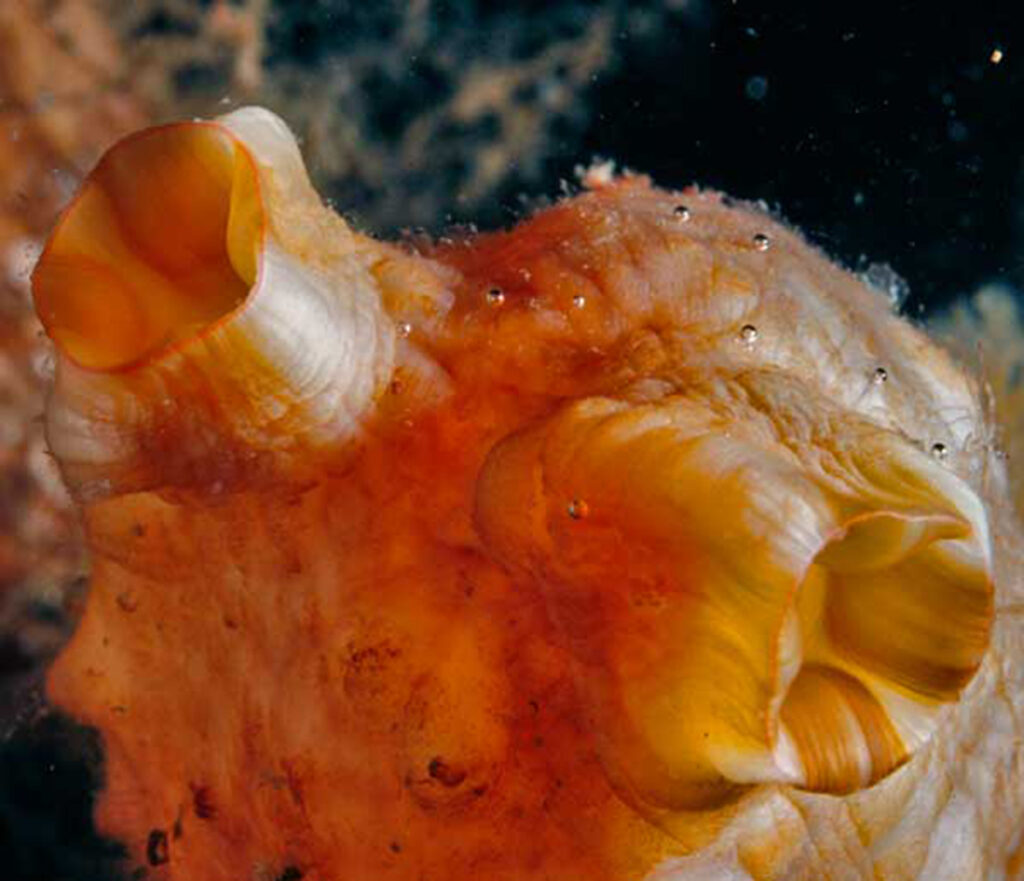
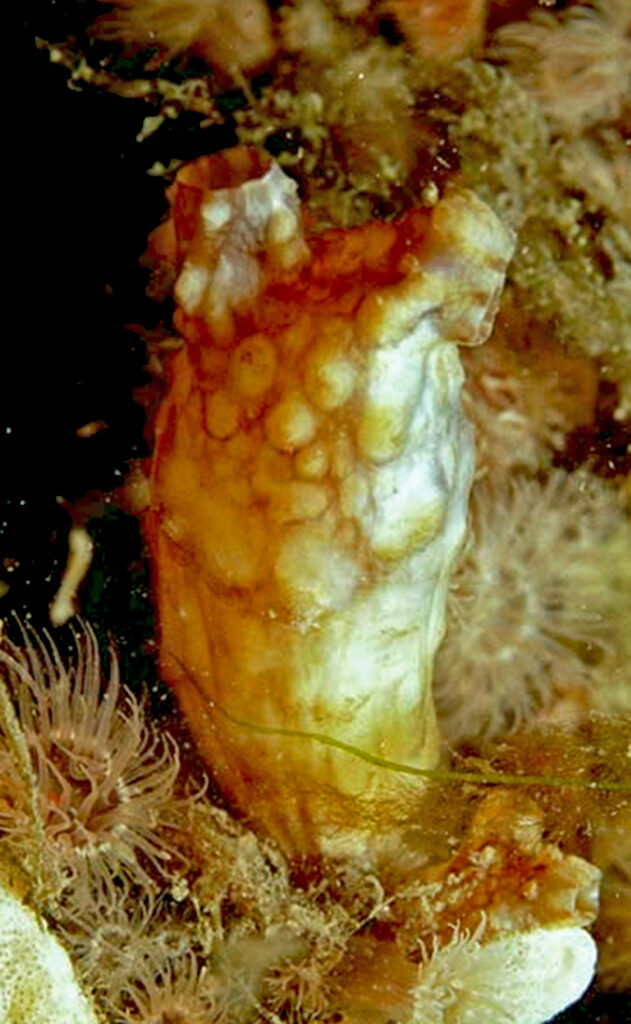
The club tunicate
Styela
Also known as: rough sea squirt / leathery sea squirt / folded sea squirt
What does it look like?
Styela clava is a brown solitary tunicate that is usually about 10 cm in length. It is attached to a hard substrate by a small flat holdfast at the base of a narrow stalk giving it a “club like” appearance. It has a tough leathery brown mantle (surface or skin) with folds and swellings. The two siphons are close together at the anterior end and have a white/brown stripy pattern.
Distinguishing features
Solitary sea-squirt attached to the surface on a narrow stalk. It has a leathery brown mantle (surface or skin) with a white/brown pattern of stripes on the siphons.
Confusion with similar species
There are no native or non-native species established in western European waters that closely resemble Styela clava.
What is its origin?
Northwest Pacific
Habitat
This is a fouling species that can inhabit hard natural and artificial substrates, from cobble and gravel, to shellfish beds and floating pontoons. Although it inhabits constantly submerged habitats, it can survive being out of the water for extended periods of time. It’s tough leathery brown mantle (surface or skin) can protect it against sudden changes in salinities caused by rainfall, enabling it to survive in both saline and slightly brackish waters.
Presence in Ireland
Present on the island of Ireland
Behaviour and Spread
Styela clava larvae have a pelagic phase of up to 27 hours. As a result natural dispersal is limited. Settled individuals are mainly spread within hull fouling communities and with shellfish transports. Locally, in for example Nova Scotia, Styela clava can form dense populations on mussel lines forming monocultures. Styela clava is already widespread in West Europe and within Ireland but such dense populations have not been recorded here yet.
Potential nuisance for aquaculture
The species can cause a nuisance for both mussel and oyster fisheries as the club tunicates can settle on these shellfish. Their leathery mantle (surface or skin) and strong attachment make them difficult to kill and/or remove.
In Nova Scotia dense populations of S. clava have formed mussel lines and have been responsible for the bankruptcy of many shellfish farmers the weight of the S. clava caused the mussel crop to fall off the lines.
In Europe such S. clava densities on shellfish have yet to be recorded.
Key Management Actions
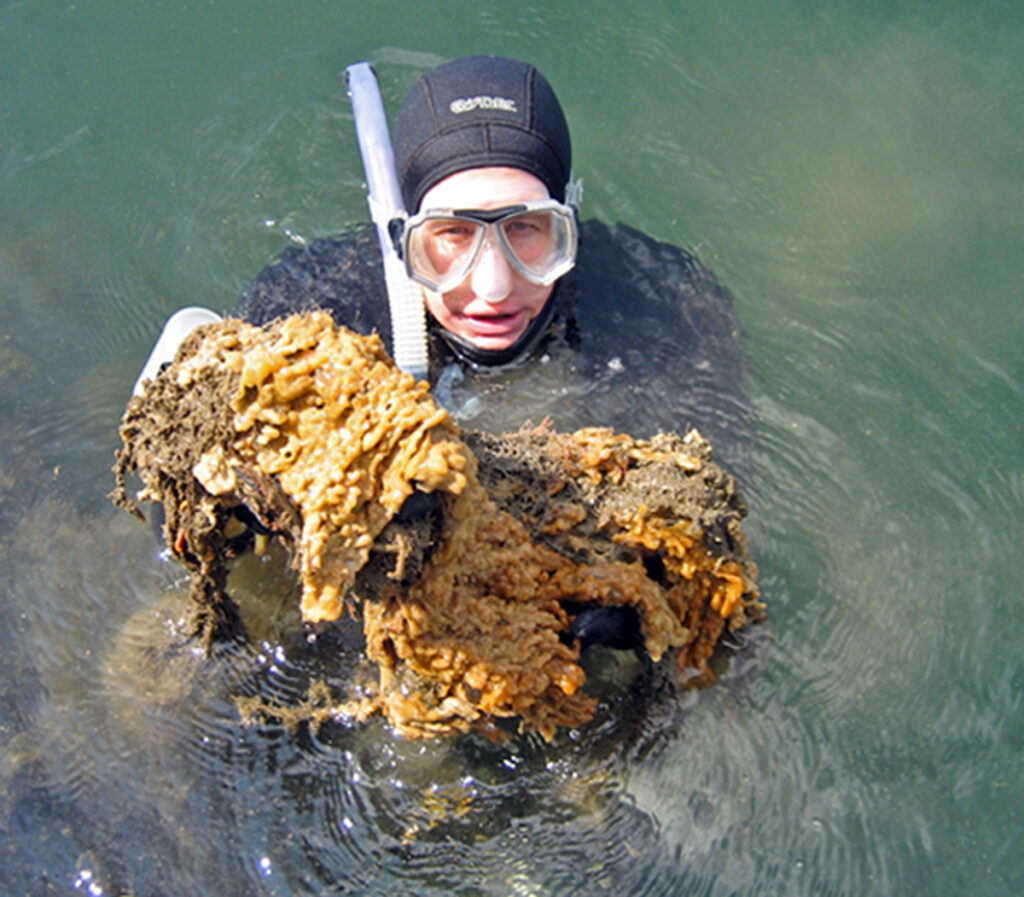
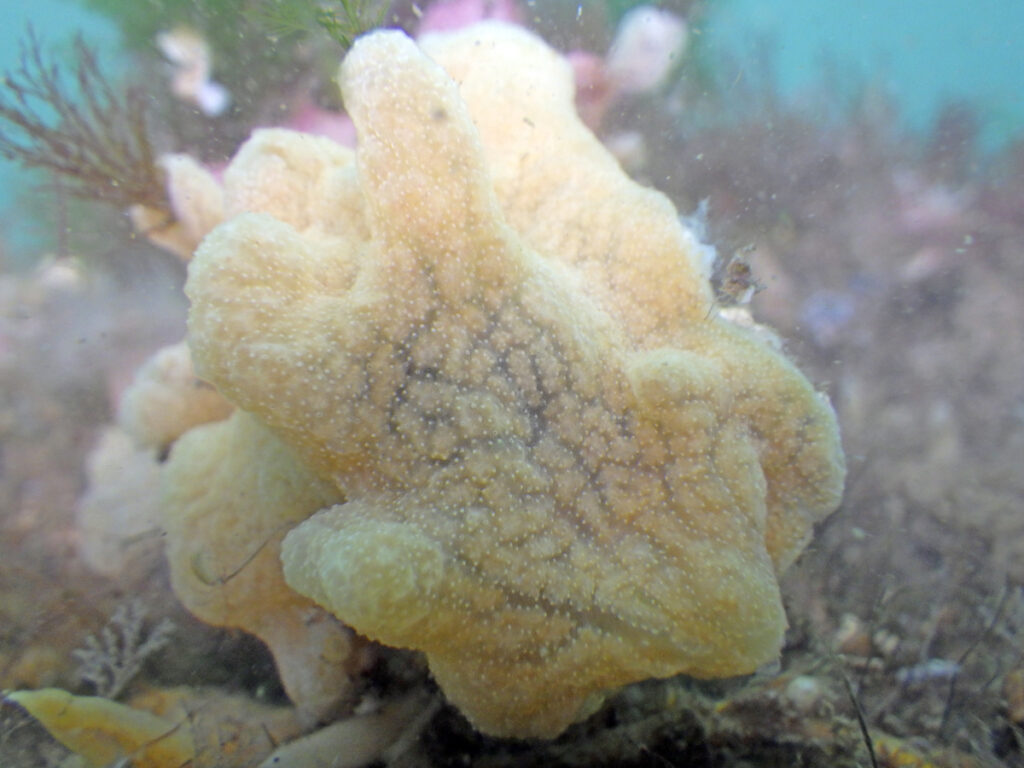
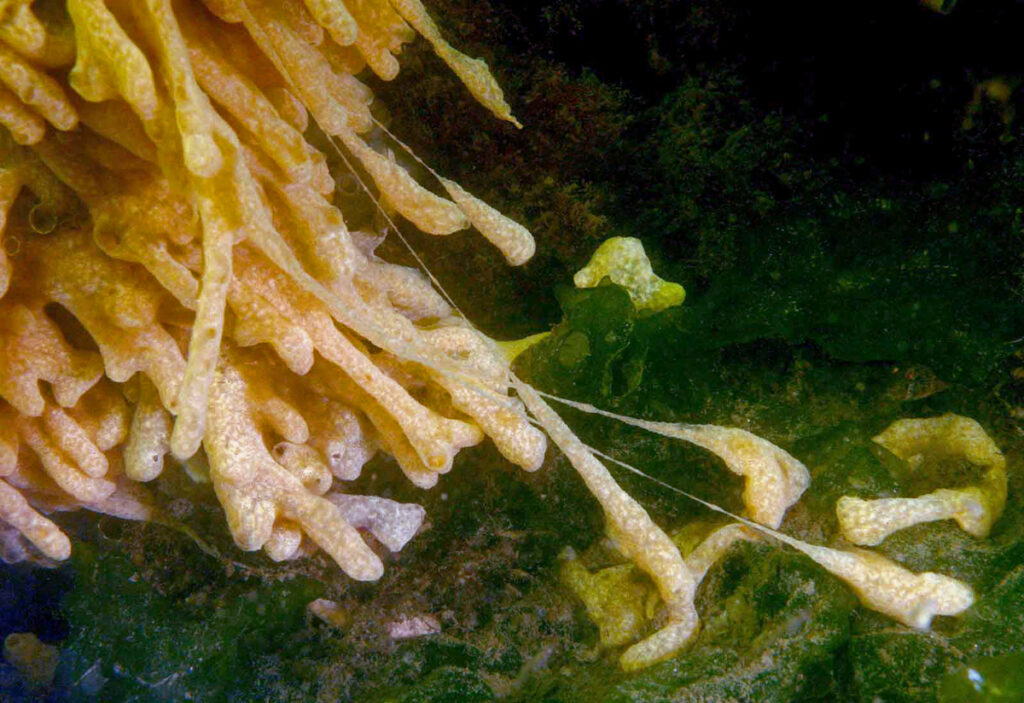
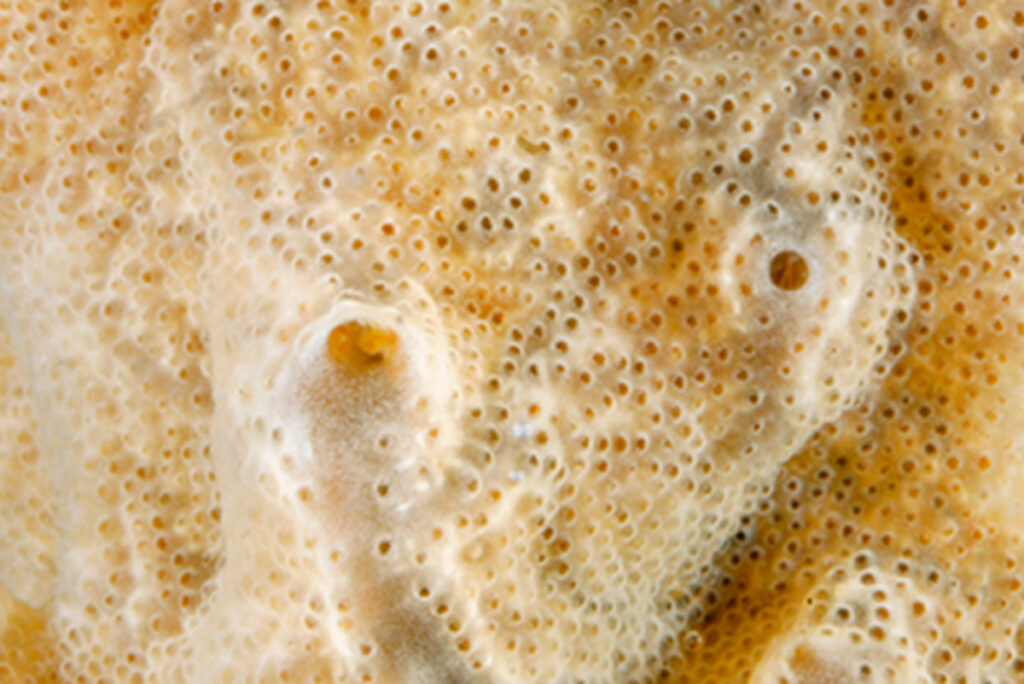
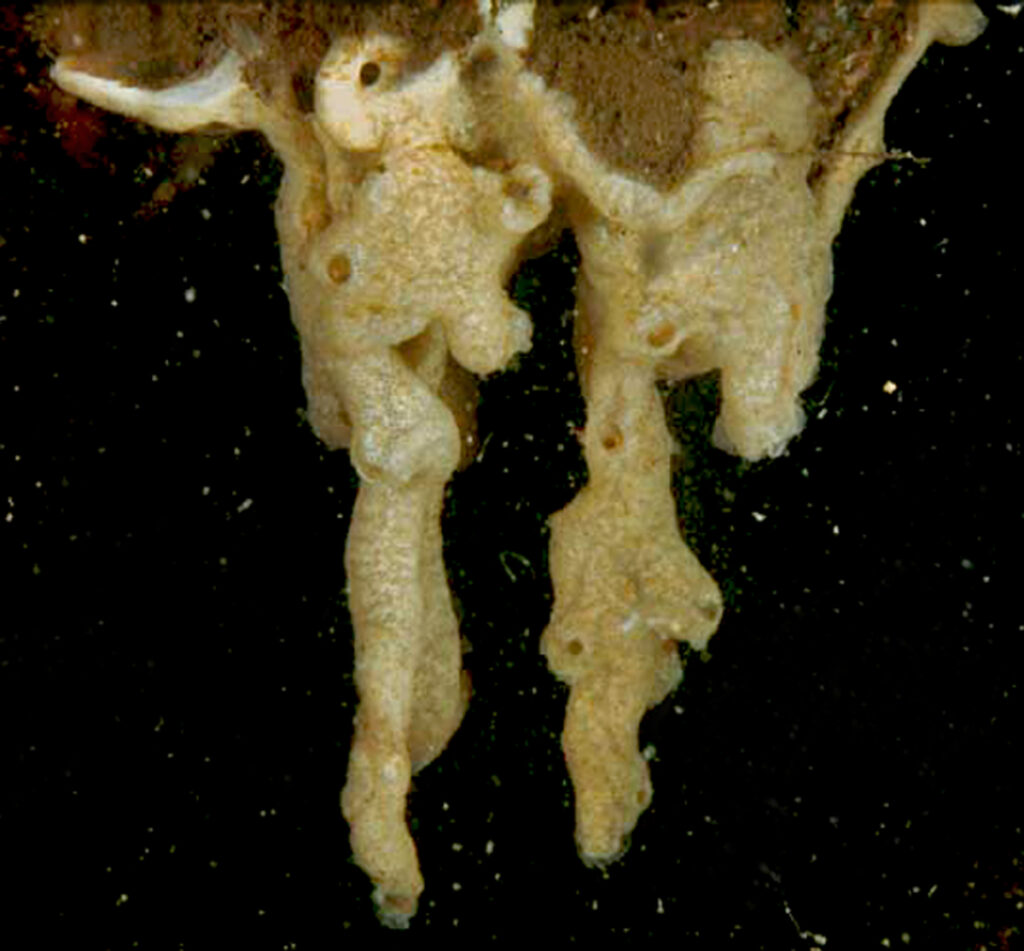
The carpet sea squirt
Didemnum vexillum
Also known as: compound sea squirt, dripping sea squirt
What does it look like?
Didemnum vexillum is a colonial sea squirt, whitish-yellow in colour. The colonies form large sheets and lobes that can cover the bottom and everything on it. Each of the separate individuals (zooids) in the colony can be identified by a small hole (“inhalant siphon”) that closes when touched.
Distinguishing features
Colonial ascidians can be distinguished from similar looking sponges, by the fact that ascidians have muscles and sponges do not. As a result, if a colonial ascidian is disturbed, it will close the openings in the colony, while no movement is seen in sponges.
In general D. vexillum can be distinguished from native white didemnid species by being abundantly present in a region. Most native species are relatively rare, while D. vexillum colonies are generally found in much higher densities, i.e. various colonies can be found close together.
On more detailed examination, colonial ascidians like Didemnum have large numbers of similarly sized more or less circular openings, while most of the openings present in a sponge tend to be smaller, irregular and vary strongly in size and form. To distinguish Didemnum from other whitish colonial ascidian species one may have to look through a microscope at a piece of the colony at the calcareous spicules it has inside. These are little ball like structures with spikes in all directions.
Confusion with similar species
Didemnum vexillum can be confused with other native Didemnid species and some sponges. Unlike other colonial sea squirts, Didemnum vexillum does not usually have black /brown markings on its surface. It also tends to be locally more abundant and occur in higher densities than other didemnid species. Compared with sponges, Didemnum have large numbers of similarly sized almost circular openings, while most of the openings present in a sponge tend to be smaller, irregular and vary strongly in size and form.
What is its origin?
Northwest Pacific
Habitat
This is a fouling species that can inhabit hard natural and artificial substrates, from cobble and gravel, to shellfish beds and floating pontoons. In more sheltered areas the species can grow over sandy and muddy bottoms. It lives mainly in submerged habitats and can be very abundant on marina pontoons, boat hulls and other marine floating structures like those used for mussel rope culture. The species can withstand short periods above water, e.g. just above the low water line, although it does not survive being exposed to fresh water (rain) very well. This enables it to settle on the underside of oyster trestles, but not on top of them if located in the higher intertidal zone.
Presence in Ireland
Present on the island of Ireland
Behaviour and Spread
Didemnum vexillum colonies produce larvae with a relatively short pelagic stage of a few hours to days in spring. The colonies can rapidly expand in summer time and only partly die off in winter. Spread by natural dispersal occurs mainly by fragments that break of the relatively fragile colonies. These fragments may drift over large distances with the residual sea-currents. Anthropogenic vectors mainly concern hull fouling and shellfish transports over relatively short distances as the species cannot survive being above water for too long.
Potential nuisance for aquaculture
Didemnum vexillum can cause a nuisance to mussel and oyster farmers as it can cover mussel lines, shellfish growing on the bottom and oyster trestles, bags and cages. By doing so, water (and nutrient) flow to the shellfish is decreased, possibly resulting in a lower shellfish meat contents. In addition D. vexillum colonies may strongly reduce the settlement success of the shellfish spat, when covering large parts of the bottom.
Key Management Actions